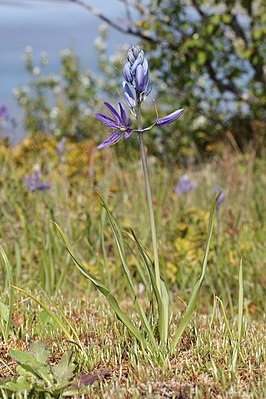Edible prairie lily
| Edible prairie lily | ||||||||||||
|---|---|---|---|---|---|---|---|---|---|---|---|---|

Camassia quamash subsp. maxima |
||||||||||||
| Systematics | ||||||||||||
|
||||||||||||
| Scientific name | ||||||||||||
| Camassia quamash | ||||||||||||
| ( Pursh ) Greene |
The edible prairie lily ( Camassia quamash , Syn . : Phalangium quamash Pursh ), also called Quamash , is a species of plant that belongs to the genus prairie lily ( Camassia ) in the subfamily of the agave family (Agavoideae).
description
The edible prairie lily is a perennial herbaceous plant that can reach a height of 20 to 80 cm. This geophyte forms spherical onions as persistence organs with a diameter between 1 and 5 cm. The mostly fewer than ten leaves are keeled, sometimes blue-green in color and are in a basal rosette. They are 10 to 60 cm long and 4 to 20 mm wide.
It forms racemose inflorescences . The mostly 10 to 35 (4 to 58) flowers are hermaphroditic, mostly zygomorphic or, more rarely, radial symmetry and threefold. There are six equally multiform bloom present whose colors vary between bright and very dark shades of blue; they are 12 to 35 mm and 1.5 to 8 mm wide. There are six free stamens . The anthers are mostly yellow, sometimes bluish purple, purple or brown. Three carpels have become a top permanent ovary grown. The stylus is thread-shaped and the stigma is three-lobed. The flowering period extends from May to July.
The egg-shaped capsule fruits do not dry completely even when ripe, are light green to light brown, 6 to 19 mm long and contain 15 to 30 seeds. The blackish seeds are 2 to 4 mm in size.
distribution
The edible prairie lily occurs in western North America . It is found in the states of British Columbia and Alberta in Canada, as well as California , Oregon , Washington , Idaho , Montana , Nevada , Utah and Wyoming in the United States. It grows in damp forests, meadows and on banks and can be found up to altitudes of 3300 meters.
Importance to humans
The name Quamash comes from the Nez Perce language and describes the edible onion. These onions were collected by the Northwest coast Indians and were used for food. For this purpose, they were dried, roasted, steamed or boiled, as was the case with the Cree and Blackfoot , but especially with the coastal Salish tribes. They could be kept dry for a long time and served as winter supplies. The onions can also be eaten raw. On the Pacific coast, Camassia quamash was an important commodity, especially the coastal Salish, which was brought to California and Alaska and traded. When dried and ground, it also served as a binding agent for dough.
The edible prairie lily is rarely used as an ornamental plant for borders, rock gardens and natural gardens. It has been in culture since 1826 at the latest. There are several types (selection):
- 'Orion': The flowers are pure purple.
- 'Blue Melody': The flowers are blue, the leaves are white.
Subspecies
There are eight subspecies:
- Camassia quamash subsp. azurea (A.Heller) Gould : It occurs in northwest Washington.
- Camassia quamash subsp. breviflora Gould : It occurs from Washington to northeastern California.
- Camassia quamash subsp. intermedia Gould : It occurs only in southwest Oregon.
- Camassia quamash subsp. linearis Gould : It only occurs in western California.
- Camassia quamash subsp. maxima Gould : Grows on damp meadows, fields and on rocky coasts at altitudes between 0 and 600 meters British Columbia, Oregon and Washington.
- Camassia quamash (Pursh) Greene subsp. quamash : Grows in damp meadows at altitudes between 300 and 2500 meters in Alberta, British Columbia; Idaho, Montana, Oregon, Washington, Wyoming.
- Camassia quamash subsp. utahensis Gould : It occurs in Idaho, Montana, Wyoming and Utah.
- Camassia quamash subsp. whale polei (Piper) Gould : Found only in southwest Oregon.
In Canada there are only three subspecies: In British Columbia only the subspecies Camassia quamash subsp. quamash , Camassia quamash subsp. maxima and Camassia quamash subsp. azurea , in Alberta only Camassia quamash subsp. quamash .
swell
- Entry in the Flora of North America (English).
- Eckehart J. Jäger, Friedrich Ebel, Peter Hanelt, Gerd K. Müller (eds.): Rothmaler excursion flora from Germany. Volume 5: Herbaceous ornamental and useful plants . Spectrum Academic Publishing House, Berlin Heidelberg 2008, ISBN 978-3-8274-0918-8 .
Individual evidence
- ↑ Cf. (PDF, 80 kB): Alan H. Hartley: The Inland Etymology of Camas , 2001 ( Memento of December 25, 2011 in the Internet Archive ), November 25, 2011.
- ↑ Native American Ethnobotany Database ( Memento of the original from January 20, 2009 in the Internet Archive ) Info: The archive link was inserted automatically and has not yet been checked. Please check the original and archive link according to the instructions and then remove this notice. , University of Michigan
- ↑ See, for example, the essay on Beacon Hill Park in Victoria : Janis Ringuette, Beacon Hill Park History 1842-2004 ( Memento of the original from August 20, 2007 in the Internet Archive ) Info: The archive link was inserted automatically and has not yet been checked. Please check the original and archive link according to the instructions and then remove this notice. .
- ↑ a b c d e f g Rafaël Govaerts (Ed.): Camassia quamash - data sheet at World Checklist of Selected Plant Families of the Board of Trustees of the Royal Botanic Gardens, Kew. Last accessed on September 13, 2016.
- ↑ See Natural Resources Conservation Service, Plants Profile, Camassia quamash (Pursh) Greene “small camas” .